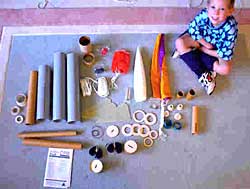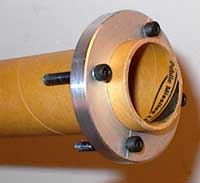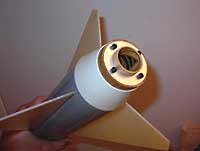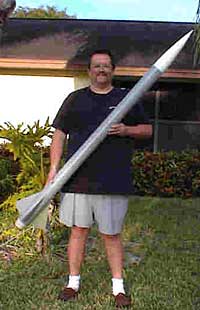| Construction Rating: | starstarstarstarstar |
| Flight Rating: | starstarstarstarstar_border |
| Overall Rating: | starstarstarstarstar |
| Manufacturer: | Public Missiles  |
Brief:
Electronics only recovery using the new Close Proximity Recovery System. Apogee drogue with main parachute at user selected altitude. PML Quantum tubing with G10 glass fins make this three fin boatailed beauty darned near indestructible.
 Construction:
Construction:
This is a fairly sophisticated kit consisting of over 50 parts. Three sections of Quantum tubing, one slotted for fins, one main chute and one drogue chute compartment. The altimeter bay adds greatly to the parts count.The excellent instructions make the assembly very easy, but you would be well advised to test fit all components together in order to understand the assembly order. The only parts needing sanding were the pistons. This airframe uses two, one for drogue and one for the main chute. Pistons bother some people; they require attention to detail and occasional cleaning. The Quantum airframe makes piston maintenance very simple. A quick pass with a baby wipe and it's good to go.
Excellent instructions. Everything fits the first time. Order of assembly makes sense. I put her together with Raka epoxy. I used the fast catalyst. It's made by a boat hull manufacturer so their fast epoxy, when spread thin, takes about an hour to set up. Make sure you lightly scuff the Quantum and the G10 fins in order to provide some tooth for the epoxy to bond to.
This rocket comes with the 29mm/38mm/54mm Kwik-Switch motor mount system. The boat tail leaves little provision for motor retention. PML recommends an AeroPac retainer. A little creativity will help you come up with a couple of lower cost alternatives.
One limitation of the Kwik-Switch mount is it limits the length of motors that can be used. The practical limit is about 12" or a J350 in a 38 MM case.
When built according to directions, you must use electronic deployment. A couple of well-placed holes drilled in the bulkhead of the fin can will convert this rocket to motor ejection.
Finishing:
Quantum tubing means NO SPIRALS to fill! It also means a light sanding in order to get the paint to stick. PML provides a couple of advertising decals.
Construction Rating: 5 out of 5
 Flight:
Flight:
First flight was on an H-123. Using altimeter deployment, drogue at apogee followed by main at 800'. Conditions were very windy. Rocket left the pad nearly vertical but encountered a gust at about 30' veering off at about an 85-degree angle. Nosed over at apogee and fell ballistically for what seemed like forever but in reality, was probably only one or two seconds. The drogue fired followed almost immediately by the main. Rocket recovered in perfect condition.
The 29mm motor was retained by Kaplow clips. Instead of the plywood centering ring (which is a 29 to 54mm adapter that slips inside the 54mm mother tube) I used a piece of 1/4" aluminum with tapped screw holes in place of T-nuts. Reported altitude was 950 ft.
 The second flight was on a 38mm H-242. The 38mm Kwik-Switch tube uses a 38mm to 54mm centering ring which is too narrow to provide room for threading or T-nuts. I cut two narrow slots into the ring (which is epoxied to the 38mm motor mount tube). I formed two Kaplow style hooks with an "L" shaped hook on the end that would normally screw into the T-nuts. This hook passes through the slot in the centering ring and locks behind it. When the Kwik-Switch motor mount is screwed into the mother tube the clips are captured behind the bulkhead.
The second flight was on a 38mm H-242. The 38mm Kwik-Switch tube uses a 38mm to 54mm centering ring which is too narrow to provide room for threading or T-nuts. I cut two narrow slots into the ring (which is epoxied to the 38mm motor mount tube). I formed two Kaplow style hooks with an "L" shaped hook on the end that would normally screw into the T-nuts. This hook passes through the slot in the centering ring and locks behind it. When the Kwik-Switch motor mount is screwed into the mother tube the clips are captured behind the bulkhead.
Beautiful straight lift with the same weather cock at about 100'. This time I set the altimeter (PML Co-Pilot) to 400' deployment. The rocket did the same thing, pitching over at apogee and falling like a lawn dart for about 2 seconds before deploying the drogue, followed by the main several seconds later at about 400' estimated. Altimeter beeped out 1045'. Close enough to win me the predicted altitude contest!
I contacted PML about the slight delay at apogee. They seemed sure that it was caused by the weather cocking and the fact that the rocket was moving in less than a vertical attitude. Subsequent ground testing of the Co-Pilot altimeter confirmed normal function.
Recovery:
Recovery (other than heart stopping delay at apogee) was perfect. Dual pistons functioned exactly as planned. No wadding required. Tubular nylon shock cord (white) didn't even look dirty.
Dual deployment charges require accurate measuring of black powder charges to ensure reliability. Fresh battery (9 volt) and good electric matches are a MUST.
 Flight Rating: 4 out of 5
Flight Rating: 4 out of 5
Summary:
Pros: Excellent design, perfect materials, excellent documentation.
Cons: You have to log onto their web site to get the recommended motor listing. Can't handle longer high power motors without modification.
Overall Rating: 5 out of 5
Other Reviews
- Public Missiles Sudden Rush By Barry Lynch
Public Missiles - Sudden Rush review is provided courtesy of: PML’s Sudden Rush with CPR 2000 Assembly, CPR 2000 Information, Kwik-Switch 2000 Information PML's Close Proximity Recovery (CPR) 2000 parts with altimeter My first attempt at dual deployment came in the form of Public Missiles' Sudden Rush kit featuring the new Quantum Tube airframe. I had ...
 |
 |
Flights
 |
 |
M.L. (February 1, 2001)
K.D. (July 2, 2002)
J.C. (June 19, 2004)
Sponsored Ads
 |
 |












B.O'B. (January 1, 2001)